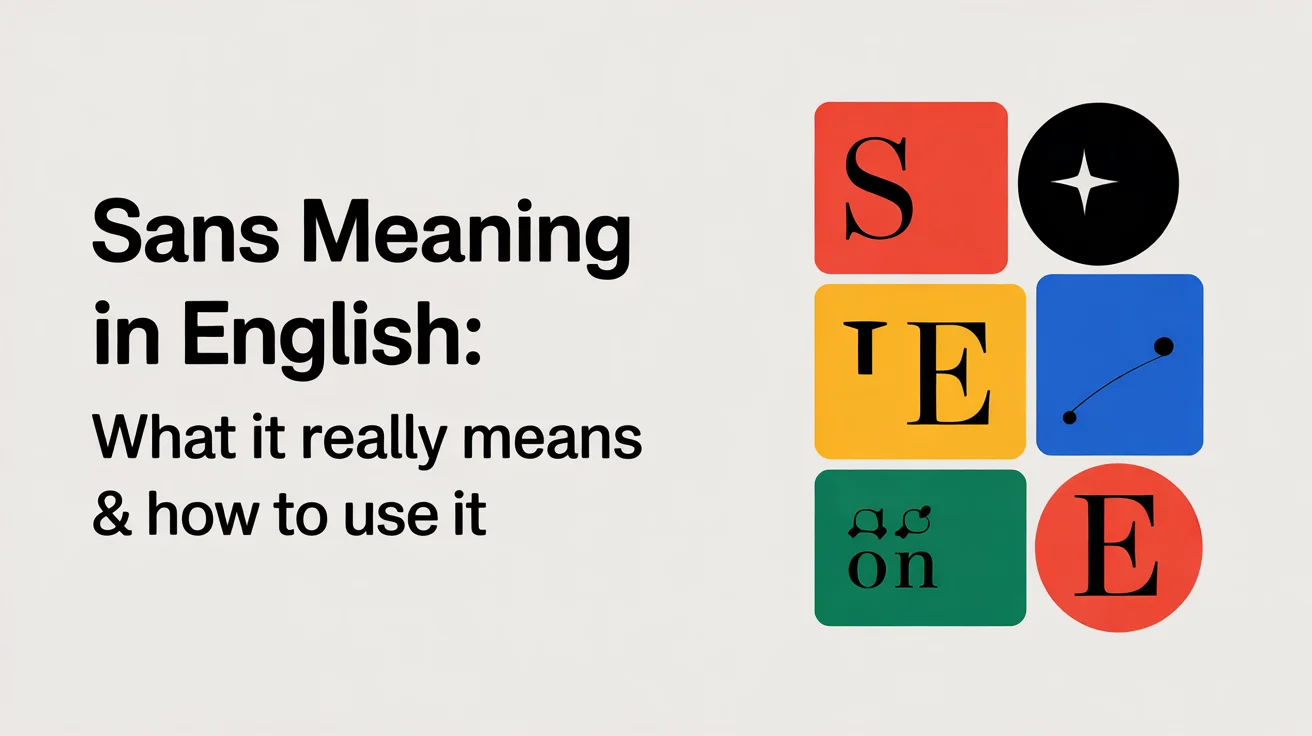Language has a way of holding onto certain elegant words that never truly fade away. One such word is “sans.” You might have stumbled upon it in literature, fashion blogs, or even a casual meme that reads “Coffee sans milk.” But what exactly does “sans” mean in English, and when should you use it?
This guide breaks down the real meaning of sans, its origins, and how to use it naturally in writing and speech. We’ll explore examples, usage contexts, stylistic nuances, and practical tips—so by the end, you’ll know exactly when this word adds flair and when to leave it out.
What Does “Sans” Mean in English?
At its core, “sans” means “without.” It’s a preposition used to indicate the absence of something. Think of it as a more formal or stylized version of without.
For example:
- “He went to work sans tie.”
- “The dish is delicious even sans cheese.”
In both cases, sans functions exactly like without—but adds a touch of sophistication or irony, depending on the tone.
| Word | Part of Speech | Meaning | Example |
| Sans | Preposition | Without, lacking | She went out sans umbrella. |
Quick definition: According to Merriam-Webster, sans means “without” and comes from Middle English via Old French.
Etymology and Origin of “Sans”
The story of “sans” is rooted in history. It comes from the Old French word “sanz” or “sans,” meaning without, which in turn derived from the Latin “sine.”
English borrowed it around the 14th century, likely through early French influence during the Norman period. Back then, English speakers absorbed a great deal of French vocabulary, especially in law, literature, and art.
Historical Usage Example
William Shakespeare used “sans” in As You Like It (Act 2, Scene 7):
“Last scene of all,
That ends this strange eventful history,
Is second childishness and mere oblivion,
Sans teeth, sans eyes, sans taste, sans everything.”
This early usage shows how “sans” was already poetic shorthand for “without,” carrying emotional and literary depth.
Pronunciation of “Sans”
The pronunciation of “sans” slightly varies depending on region and accent:
| Accent | Pronunciation | Phonetic |
| American English | “sanz” | /sænz/ |
| British English | “san” | /sæn/ or /sɑːn/ |
| French origin | “sahn” | /sɑ̃/ |
Both “sanz” (with a “z” sound) and “san” are acceptable in English today.
So if you say “sans makeup” as /sænz ˈmeɪ.kʌp/ or /sæn ˈmeɪ.kʌp/, you’re correct either way.
How “Sans” Is Used in Modern English
While sans once belonged to the poetic realm, today it pops up in everyday writing—especially in journalism, design, and casual expression.
Here’s how people use it naturally:
Common Sentence Patterns
- “She arrived sans phone.”
- “He completed the project sans coffee.”
- “We enjoyed the party sans drama.”
It’s most often used as:
👉 [Subject] + [verb] + sans + [noun]
This simple formula keeps it readable and stylish.
When to Use “Sans” vs “Without”
Even though “sans” and “without” share meaning, they differ in tone and context.
| Comparison Point | Sans | Without |
| Tone | Stylish, witty, or literary | Neutral and standard |
| Common in | Writing, media, design | Everyday speech and writing |
| Example | “She walked in sans shoes.” | “She walked in without shoes.” |
| Best for | Adding flair or brevity | Clarity and directness |
Rule of thumb:
- Use “sans” when you want your sentence to stand out or sound refined.
- Use “without” when you want to keep things simple or conversational.
Popular Collocations and Phrases Using “Sans”
Some combinations with “sans” have become set expressions in English. Let’s explore the most popular ones
1. Sans Serif
You’ve probably seen this one if you’ve ever used Microsoft Wod or Canva.
- Meaning: Typeface without decorative strokes or “serifs.”
- Example: Arial, Helvetica, and Calibri are sans serif fonts.
| Typeface Example | Category |
| Times New Roman | Serif |
| Arial | Sans Serif |
| Helvetica | Sans Serif |
| Garamond | Serif |
This usage is purely technical but shows how “sans” naturally integrated into English vocabulary.
2. Sans Makeup
A modern favorite in lifestyle or beauty writing.
- Example: “She appeared on Instagram sans makeup, embracing natural beauty.”
- Often used to suggest authenticity or confidence.
3. Sans Filter
- Common on social media when posting unedited photos.
- Example: “Sunset, sans filter.”
4. Sans Pants
- Humorous or informal tone.
- Example: “Working from home, sans pants.”
“Sans” adds personality—it’s a wink to the reader that you’re being clever or ironic.
How Common Is “Sans” Today?
While not an everyday word, “sans” appears frequently in magazines, blogs, and pop culture because of its playful sophistication.
Here’s a quick data snapshot:
| Context | Frequency | Notes |
| Academic Writing | Low | Too casual or stylized |
| News Articles | Medium | Used in headlines or witty phrases |
| Fashion & Design | High | Common in typography and style writing |
| Social Media | High | Used for brevity or humor |
So, while you might not say “sans” often in conversation, you’ll see it everywhere in writing—from Vogue headlines to tech blogs.
Common Mistakes When Using “Sans”
Even though it’s a short word, “sans” is often misused. Let’s clear that up.
1. Using it before verbs
❌ He finished sans taking a break.
✅ He finished sans a break.
“Sans” modifies nouns, not verbs.
2. Overusing it for style
Using it too often can make writing sound forced. Balance is key:
“A clever touch of ‘sans’ adds polish; too much makes it pretentious.”
3. Confusing register
“Sans” fits formal or witty writing—not serious reports or instructions.
For example:
- ✅ “Minimalist design sans clutter.”
- ❌ “Please submit the form sans signature.”
How to Use “Sans” Effectively
Here’s how to master this little word and use it like a pro:
1. Match Tone to Context
Ask yourself: Is your tone playful, literary, or journalistic?
If yes, “sans” might fit perfectly.
2. Keep It Brief
Use it with short, impactful phrases:
- “Breakfast, sans eggs.”
- “Monday morning, sans motivation.”
3. Reserve It for Emphasis
Sprinkle it sparingly to highlight contrast or irony:
“A party sans music is no party at all.”
4. Know Your Audience
Use “sans” if your readers will appreciate the stylistic twist. Avoid it in technical documents or business reports where clarity trumps creativity.
Read More: Charizarding Meaning in Slang and Text Messages
Real-World Examples of “Sans” in Sentences
| Sentence | Tone | Explanation |
| “She stepped on stage sans fear.” | Motivational | Expresses confidence without using “without.” |
| “The dish was rich sans cream.” | Culinary | Suggests creativity or dietary substitution. |
| “He faced Monday sans coffee.” | Humorous | Highlights a relatable struggle. |
| “They redesigned the logo sans serif fonts.” | Technical | Describes typography clearly. |
| “He smiled sans regret.” | Literary | Adds emotional weight to description. |
Mini Practice: “Sans” or “Without”?
Try guessing which sounds better.
| Sentence | Better Fit | Explanation |
| She left home ___ her phone. | Sans | Playful, modern tone |
| The report was submitted ___ data. | Without | Formal, serious tone |
| The photo was posted ___ filter. | Sans | Social media slang |
| He spoke ___ hesitation. | Without | More natural |
| The model walked ___ shoes. | Sans | Fashion/lifestyle context |
Related Words and Synonyms for “Sans”
Here are some alternatives depending on tone and style:
| Synonym | Meaning | Use Case |
| Without | Neutral, standard | Most contexts |
| Lacking | Suggests incompleteness | “Lacking motivation” |
| Free from | Implies absence of something unwanted | “Free from errors” |
| Devoid of | Formal or scientific | “Devoid of life” |
| Bereft of | Literary | “Bereft of hope” |
Each has its own flavor—but “sans” stays distinct because of its elegance and brevity.
Style Tip: Why Writers Love “Sans”
Writers, advertisers, and editors often choose “sans” for its minimalist charm.
- It’s short, sharp, and memorable.
- It helps headlines stand out (“Style Sans Effort”).
- It conveys modernity and confidence—perfect for branding.
Example:
A fashion brand slogan:
“Simplicity, sans compromise.
That’s powerful—concise and classy.
Quick Case Study: “Sans” in Branding
Case: Google Fonts and Typography
When Google launched Open Sans, it wasn’t just naming a typeface—it was sending a message: clean, modern, no frills.
- “Sans” implied simplicity without excess.
- Designers embraced it as the go-to modern font family.
- It now ranks among the most downloaded web fonts globally.
This shows how one little French word became a global design symbol for clarity and minimalism.
FAQs About “Sans Meaning in English”
Q: Is “sans” the same as “without”?
Yes, in meaning—but not always in tone. “Sans” sounds more stylish or old-fashioned.
Q: Can I use “sans” in formal writing?
Only if your audience appreciates the flair. Avoid in business or academic contexts unless it’s a direct quote or title.
Q: Is “sans” still French?
It originated from French but has been fully absorbed into English vocabulary for centuries.
Q: Is “sans” plural or singular?
It’s neither—it’s a preposition. It doesn’t change with number or tense.
Q: How do you pronounce “sans”?
In the US, /sænz/ (“sanz”). In the UK, /sæn/ or /sɑːn/. Both are accepted.
Conclusion
To sum it up, “sans” means “without,” but it’s more than just a synonym. It’s a stylistic choice—a way to add sophistication, wit, or punch to your writing.
Use it sparingly, purposefully, and with awareness of your audience. The next time you’re writing, try swapping “without” for “sans” where it fits naturally.
“Good writing is clarity, sans clutter.”
Whether you’re crafting a headline, writing a caption, or polishing a blog, mastering small nuances like “sans meaning in English” makes your language sharper and more expressive.

Founder of PunnyPeeks and master of celebration magic, David Mass is the creative spark behind the brand’s bold, balloon-filled brilliance. With an eye for color, a flair for design, and a passion for making people smile, David transforms events into unforgettable experiences. From quirky puns to perfectly curated party decor, he believes that every occasion deserves a splash of fun and a whole lot of heart.




